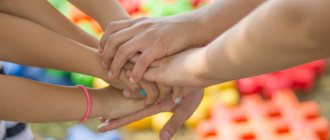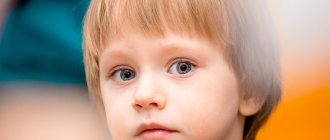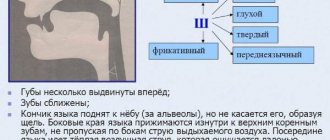Theme of the logorhythmic lesson: “In the autumn forest”
Non-speech goals:
- development of coordination of movements, orientation in space;
- development of auditory perception, attention, memory;
- developing the ability to work in a team of peers;
- development of a sense of rhythm and ear for music;
- development of creative thinking;
- normalization of muscle tone.
Speech goals:
- development of speech breathing and voice formation;
- development of facial and articulatory motor skills;
- synchronization of speech with movement;
- development of prosodic components;
- activation of the dictionary on lexical topics “Autumn”, “Forest”, “Trees”, “Wild Animals”.
Equipment: plot painting “Autumn Forest”; toy trees; dummies of mushrooms (or object pictures); fairy-tale characters - hedgehog, bear; wooden spoons, rattles, technical means for playing music.
How exactly does logorhythmics help children 3-4 years old?
After practicing logorhythmics, children become more rhythmic, they move better and more, sing and talk. If you conduct your classes correctly and maintain the unity of the components, good results will soon please you.
How do classes affect children?
- the child learns to exhale correctly while speaking
- an ear for music appears
- active children slow down, and slow children become more active
- sounds during conversation become clear, motor skills actively develop
- These children develop agility, strength and endurance
- children keep their backs straighter and their posture becomes more beautiful and graceful
It is recommended to engage in logorhythmics during the period when the child begins to develop speech, especially if there are disturbances in the speech apparatus. And the lag in speech is followed by other consequences.
Senior group. Senior preschool age. Children 5-6 years old
Abstract of a logorhythmic lesson in the senior group “Winter Adventure” Synopsis of a logorhythmic lesson in the senior group The dominant educational area is speech Topic: “Winter Adventure”
Goal: Consolidating acquired pronunciation skills through development, education and correction of the motor sphere in combination with words and music. Correctively...
Summary of a logorhythmic lesson for children of senior preschool age “Housewarming in the forest” Logorhythmic lesson for children of senior preschool age “Housewarming in the forest” Purpose: Overcoming speech disorders through the development and correction of the motor and emotional spheres of the child. Objectives: Development of a sense of rhythm, attention; Development of coordination of speech, movement and music;…
What is logorhythmics
Logorhythmics by Zheleznova for children 2-3 years old is a whole complex of therapeutic exercises with the addition of neurogymnastics . During logorhythmics classes, children perform certain speech tasks using special movements, words and music.
The main goal of logorhythmics is to do everything possible to help every child with speech problems learn to speak correctly and clearly and develop an ear for music.
Zheleznova’s logorhythmics for children 2-3 years old is a correction method actively used by Russian specialists, during which various types of games and training are actively used.
Including such as:
- walking with a change of direction;
- breathing development tasks;
- exercises to improve muscle tone;
- articulation of poetry;
- singing.
Who needs logorhythmics?
Speech therapists widely use this method of working with children as it is quite effective and does not cause difficulties. As a rule, all children willingly move to the music, repeating the movements of the teacher.
Logorhythmics is indicated for children 3-4 years old in the following cases:
- Dysarthria, various disorders in the pronunciation of sounds.
- Delayed speech development.
- Stuttering.
- Dyslexia.
- Dysphonia.
- Speech tempo disturbances.
- Insufficiently developed fine and gross motor skills and coordination of movements.
In addition to correcting speech disorders, logorhythmic techniques are also indicated for children prone to frequent illnesses, as well as those at the stage of active speech formation.
How does logarithmics affect the development of a 3-4 year old child?
Children who practice logorhythmics are more graceful, rhythmic, and able to move expressively, sing and speak. If the unity of all components is observed, positive changes will not be long in coming.
The influence of classes on children's development:
- The child learns to make the correct speech exhalation.
- An ear for music develops.
- Children become more dexterous, large and fine motor skills improve.
- Overly active kids calm down, become more diligent, and slow children become cheerful and active.
- Articulatory motor skills develop, and the pronunciation of sounds becomes clearer.
- Strength, agility and endurance are formed, children acquire beautiful posture.
These classes are especially important during the period of speech development, when any delay in speech development entails consequences that are difficult to eliminate.
How are logorhythmics classes conducted with children 3-4 years old?
All logorhythmic exercises for children 3-4 years old are very simple and interesting; special training is not required to perform them. The adult shows and the child repeats after him. Children are not required to memorize and memorize the material; everything happens spontaneously. At first, a little help from an adult is required, but after a few lessons the kids can independently and accurately repeat the speech material.
In the video of the presentation of the song - a dramatization of the famous early childhood development teacher Zheleznova E.S.:
For a visible effect, you need to practice for at least 6-12 months, regularly conducting 2 classes per week. It is better to do this after a nap, although it all depends on the individual characteristics of the child. Children with stuttering and hesitation should practice logorhythmics at least 3-4 times a week.
Approximate structure of classes - exercises:
- Walking with tasks.
- For relaxation and tension.
- Articulation, breathing exercises.
- To develop attention and memory.
- Count from 1 to 10.
- Pronouncing the text of a poem with movements.
- On the formation of auditory attention.
- To develop a sense of rhythm, a sense of tempo.
- Singing.
- Finger gymnastics.
- Correction of incorrect pronunciation.
- To distinguish linguistic units.
Before conducting the classes, a little preparation is required - for each stage of the classes you need to select the appropriate soundtrack. It could be classics, children's songs, relaxation music, sounds of nature.
It is impossible to use a strictly defined lesson program; all lessons are adjusted to a specific child. If there are problems with motor skills - the proportion of corresponding exercises increases, sound pronunciation suffers the most - more time should be devoted to finger and articulatory gymnastics.
In no case should a child be scolded for failures, so that he does not lose interest in classes. It is better to abandon an unmastered exercise for a while, but then you still need to return to it.
In a group or individually?
If the child does not have pronounced problems that require serious correction, and logorhythmics is used to improve motor skills and general speech functions, you can practice in a group. Children happily stomp and clap to the music, sing and recite poems.
It's more fun and interesting in a group. In addition, group games can be useful for the socialization of children who are not inclined to communicate.
However, in cases where a child needs emphasis on specific exercises, it is important that the classes follow an appropriate program. If you are offered individual lessons in logorhythmics, do not refuse. In this mode, the work plan is always adjusted to the requirements of the child’s condition, which means the result will be much more noticeable.
What does logorhythmics mean? Characteristics and features
Many modern preschoolers are diagnosed with simultaneous delays in both speech and motor skills, two components that are closely related to each other. Logorhythmics, or speech therapy rhythmics, is one of the methods for eliminating speech disorders, combining movements, words and musical rhythm.
You can practice it from birth, because walking around the room with a baby in your arms while reading a nursery rhyme or listening to your mother singing a lullaby is nothing more than logarithmics. Beautiful, correct speech is the result of fine coordination of the respiratory and nervous systems, articulation and hearing organs. If at least one of these components fails, you will no longer get an impressive result.
The main task of logarithmic gymnastics is to stimulate lagging components and establish their coordinated work.
Who benefits from logorhythmic exercises:
- Children with general speech underdevelopment.
- Children whose speech is intensively developing (2.5-4 years).
- Weakened, often sick children.
- For dysarthria and dyslalia (sound pronunciation disorders).
- Children with a predisposition to stuttering and children who stutter.
- For hesitations in speech, as well as for children with tachylalia and bradyllalia (with speech that is too fast or too slow).
Logorhythmics develops not only speech, but also mental processes and stimulates physical development. Games for the formation of phonemic hearing, speech breathing, articulation, and rhythm serve to develop speech. More often than not, the same exercises achieve several goals at the same time.
The main feature of logorhythmic exercises is that almost all of them are accompanied by music or singing. Music has a strong emotional impact on a child’s psyche, adds a special flavor and helps make exercises more varied.
Speech therapy rhythm is:
- Various types of walking with complications.
- Breathing and articulation gymnastics.
- Speech development exercises without music.
- Exercises that develop fine motor skills.
- Singing.
- Exercises to focus on attention and regulate muscle tone.
Exercises that require coordination of attention simultaneously develop all types of memory: kinesthetic (motor), musical, auditory, speech, visual.
Logorhythmic games and exercises for children 3-4 years old
For individual lessons, you can choose the material yourself, or use ready-made programs. The main thing is that the structure of the lesson includes the required components, and, if necessary, the exercises are accompanied by music.
Logorhythmic games:
- Breathing exercises
We blow cotton wool from our palms, blow on paper snowflakes, blow off a piece of paper glued to the tip of our nose, blow on paper boats in a basin, blow soap bubbles.
- Sing vowels
We pull the bright colored string from the fist and sing the vowel sound as long as it stretches.
- Game "Earth, water, air"
When an adult says the word “earth” we stomp our feet, when we hear the word “water” we imitate swimming, when we hear the word “air” we wave our arms above our heads.
- Game "We Raise Our Hands"
We raise our hands, we lower our hands, we shake our heads. We stomp our feet, we clap our hands, we give them to mom, and we run around!
- "Funny Parrots"
Invite children to tap the rhythm of the syllable series suggested by adults with the edge of their palm: ta-ta-ta, ta-ta, ta-ta, ta-ta-ta, like parrots repeating each word.
- Simulation of playing musical instruments
“We came and sat down, playing the trumpet - Tu-tu-tu! Doo-doo-doo!” Next, we imitate playing the drum, rattles, balalaika, etc. You can use children's toy tools.
Video - the plot of a lesson on logorhythmics with children 4-5 years old:
Fun and varied activities will not bore the baby, and adults will be able to achieve an important goal in a relaxed manner - to develop correct, rich and beautiful children's speech.






